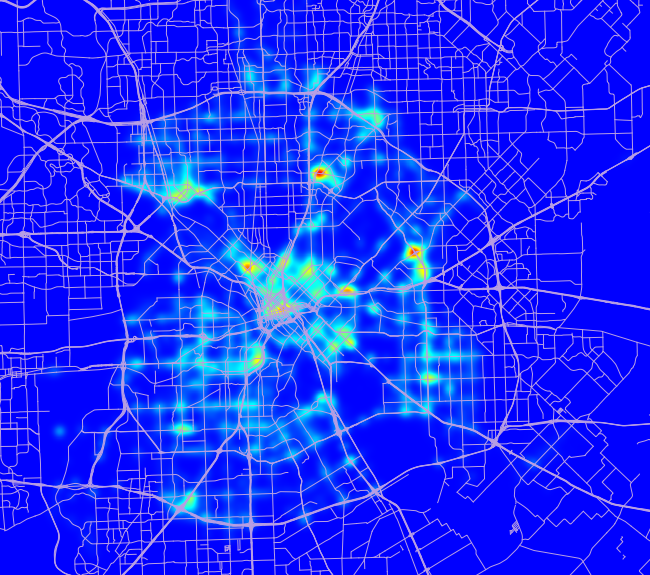Wondering where most traffic ticket are written in Dallas? The below heatmap is from a dataset that includes Dallas (city) tickets 2004-2012 and Dallas County tickets 2006-2012. (Beginning and end years are partial.)
I am assembling this dataset for my in-progress doctorate. (I am a doctoral candidate.)

A couple of notes to help interpretation:
- This is for all officer-written traffic tickets: speeding, red light running, paperwork violations, equipment violations, etc.
- Does not include:
- Tickets unrelated to traffic, like disturbing the peace or drug possession.
- Parking tickets.
- A modest % of tickets that I could not geocode due to no address, bad address data, or limitations of my geocoder.
- Portions of Dallas outside Dallas County.
- Tickets written by other jursdictions. I left out Texas Department of Public Safety because they have hardly any activity in Dallas County except for NTTA freeways. Dallas heavily patrols the NTTA-owned Mountain Creek Lake Bridge, however!
- Tickets sent directly to county courts instead of municipal or JP courts, like DUI.
- Automated ticketing machines like Dallas’s red light cameras.
- This may modestly understate Dallas County sheriff and constable tickets because I have about 2 more years of Dallas city tickets in here.
I find it surprising that the most significant traffic enforcement activities are generally not along major roadways, but rather are in areas of town commonly perceived as dangerous.
Two huge peaks are at the Five Points area (Park Ln. east of US 75) and Ferguson/Buckner. Other obvious areas of emphasis:
- Downtown
- Maple and Wycliff
- Just north of Bachman Lake
- Pleasant Grove
- Oak Cliff
- Fair Park
- North Skillman
- Red Bird area
It’s as if traffic enforcement is largely being used as a pretext for arrests and searches that might otherwise be difficult to pass constitutional muster. That may be interesting as commentary, but it is not a focus for my research. I’m really focucing on the safety effect of enforcement.
There is an apparent focus on intersections, although it’s possible that this is an artifact of officers writing in the nearest intersection for the ticket’s address.